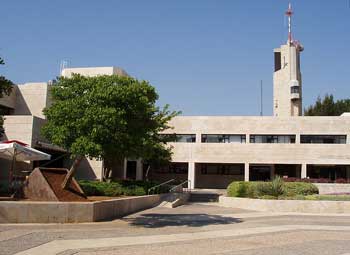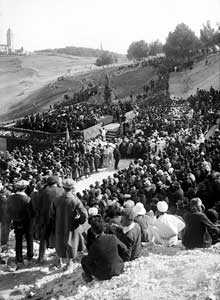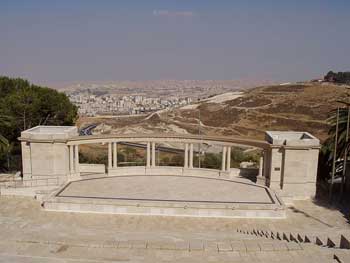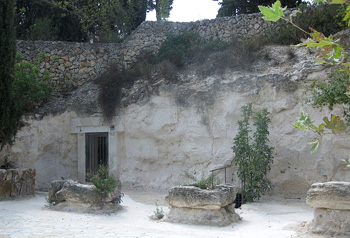Hebrew University
Jerusalem's Institute of Higher Learning
Mount Scopus Campus
Hebrew University Jerusalem’s most famous institution of higher learning also boasts a beautiful campus on Mount Scopus with stunning views that overlook both, the city of Jerusalem with the Temple Mount and, on the other side, the stark Judean dessert and the Dead Sea.

Photo by milan.sk, under a GNU free documentation license.
The university also has two other campuses – one in the Givat Ram neighborhood of Jerusalem, and one in the city of Rehovot. The Mount Scopus campus, however, is where the school was born.
History
The cornerstone for Hebrew University – the first Jewish university – was laid in 1918 on land purchased from Sir John Gray-Hill, a wealthy English lawyer. Albert Einstein, Martin Buber and Sigmund Freud were among the founders of the school, which officially opened in 1925, and they served on the first Board of Directors.

In 1948, during the War of Independence, the university was cut off from the other Jewish neighborhoods of Jerusalem. Medical staff for the university’s hospital had to travel weekly in convoys up to Mt. Scopus to relieve each other. Arabs repeatedly attacked the convoys and on April 13, 1948, they ambushed one of the convoys and massacred 79 doctors and nurses, while British police refused to intervene. After the massacre, the campus and hospital had to be abandoned.
Under the 1949 Armistice Agreements, Jordan agreed to grant Israel access to the university. Jordan reneged on the Agreements, however, and only Israeli armed forces, shuttled in every two weeks, were able to man this besieged Israeli enclave.
The university was reestablished on a new campus in Givat Ram and the medical school founded the Hadassah Medical Center in Ein Karem. It was only in 1967 that Israel regained the Mount Scopus campus.
The campus was quickly rebuilt and is now the main university center. Hebrew University ranks among the best 100 universities in the world. Six graduates of the university have won the Nobel Prize in the last 10 years. It is also home to the Rothberg International School for Overseas Students, which attracts college students from all over the world who wish to study in Israel in English.
What to See
The architecture of the campus is striking and blends in surprisingly well with the starkness of the desert it overlooks. The jewel of the campus is the stunning Hecht synagogue, whose floor to ceiling windows overlook the Temple Mount. There’s also a touch of whimsy about – look for the giant spotted lizard sculptures that climb the sides of the severe looking buildings.
Another breathtaking viewpoint is the amphitheater, which overlooks the desert. On a clear day you can see the Dead Sea. The amphitheater is often used for ceremonies and concerts. When it is deserted, it’s a unique place from which to contemplate the Judean hills.

Photo by milan.sk, under a GNU free documentation license.
In the Hebrew University of Jerusalem Botanic Gardens you’ll find more than plants. The graves of Nicanor of Alexandria and Channaniah ben Yonatan the Nazir, his wife and family are all preserved in grounds of the botanic gardens. Nicanor of Alexandria is mentioned in the Talmud (Tractate Yoma 38a). In the days of King Herod, Nicanor brought two huge bronze gates from Alexandria for the Second Temple. His gates, installed on the Western side of the Women’s Section of the Temple, were 50 cubits high and 40 cubits long.
Leon Pinsker and Menachem Ussishkin, two Zionist leaders, are buried in the courtyard before the burial caves.

Entrance to the botanic gardens is free. (Note that these are not the same gardens as the Jerusalem Botanic Gardens, also associated with the University, which are part of the Givat Ram campus and close to the Knesset building.)
To arrange a tour of the campus, contact For a virtual 350 degree tour of the Mt. Scopus campus, visit this link at the Hebrew U website.
Hadassah Medical Center is adjacent to the campus.
Also on Mt. Scopus is the British WWI Allied Military Cemetery, where are buried or memorialized 5,800 British soldiers who gave their lives in the 1916-1917 British campaign to wrest Palestine from Ottoman rule.
Return from Hebrew University Jerusalem to
Jerusalem Tours: Modern Jerusalem.
Return from Hebrew University Jerusalem to Jerusalem Home page.
Traveler's Prayer
Our Gift to You!
Take us with you!
Only have a day or two in Jerusalem? Download our guidebook and make the most of your time here.
Introduction to Jerusalem: A Guide to the Holy City
"As we had limited time in Jerusalem, I purchased your mini guide book and found it very informative. Thanks!" - Brian, S. Africa
Top 5 Jerusalem Hotels
Click here for the top 5 discount hotels in Jerusalem.
Learn to Speak Hebrew:
Make Jerusalem part of your life:
Subscribe to our FREE newsletter.
Jerusalem Video
The 6-min virtual tour







New! Comments
Have your say about what you just read! Leave me a comment in the box below.